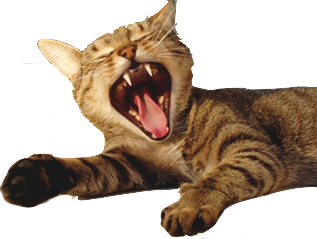Blog
What Happens During a Dental Procedure?
February 16, 2016

It’s hard to believe that it is already February—which means it is Dental Awareness Month! In past Mewsletters, we have covered many different topics about feline dentistry, including at-home dental care and preventive professional dental cleanings. Have you ever wondered more about what happens to your kitty during a professional dental cleaning? Let’s take a look at the different parts of dental surgery.
Dental procedures start with an exam and pre-operative blood work with your veterinarian. Blood work is needed to ensure that your kitty’s vital organs are working properly and that they are safe to go under anesthesia. The blood work may be taken at a previous appointment, or it can even be done the night before if your kitty spends the night with us prior to their dental procedure.
When you admit your kitty to surgery, you will meet with a technician. The technician will answer any questions you have about the procedure, as well as get an updated weight on your kitty. On the morning of the procedure, your cat is examined by the doctor, who will listen to its heart and lungs before going under anesthesia. Once they are cleared for the dental procedure, pre-anesthetic pain medication is administered. The most common pain medication is in the morphine family, and it will help your kitty feel at ease while also providing pain control if needed.
After being given the medication and relaxing a bit, an intravenous (IV) catheter is placed, and IV fluids will be started, just like in people. This will help ensure your kitty is kept hydrated throughout the procedure. When it is time for the procedure to begin, your kitty is given another injection through the IV catheter that will induce anesthesia. This lasts a short time and allows for the placement of an endotracheal (breathing) tube. The breathing tube will not only provide the longer-lasting anesthesia and oxygen, but it will also help protect your kitty’s airway and lungs from bacteria during the procedure.
Monitoring devices are then attached so that the doctor and dental technician can monitor heart rate, body temperature, oxygen saturation of red blood cells, and blood pressure. Monitoring these helps ensure your kitty will be safe the entire length of the procedure. In addition, the doctor and technician monitor the patient’s breathing, gum color, heart sounds, and depth of anesthesia. Because low body temperature can adversely affect the safety of anesthesia, we use a warming blanket, called a Bair Hugger, to help maintain the normal temperature while undergoing surgery.
Next, the dental technician will begin charting the teeth and will record any loose or fractured teeth, visible tooth resorption, root exposure, periodontal disease, or presence of gingivitis. Once everything is updated, the technician will begin scaling/cleaning the teeth, using both hand instruments and ultrasonic equipment. Having your kitty under full anesthesia allows the technician to remove the tarter from the gum line and all sides of the teeth without protest or discomfort.
After the teeth are cleaned, they are evaluated for hidden disease. The doctor gently probes under the gum line in several areas around each tooth to measure periodontal pockets or separation of the gums from the tooth root surface.

Following the doctor’s assessment of the teeth, full mouth x-rays are taken. Dental x-rays are performed, just as they are in us, by inserting a small, square digital probe into the mouth, positioning the dental x-ray cone against the cat’s mouth, and taking the image. Our dental x-rays are digital, so we are able to view them almost immediately, allowing the doctor to determine if any extractions are necessary.
If extractions are needed, a local analgesic, pain block is performed (similar to getting your mouth numbed prior to a filling at the dentist!) This helps to control pain even after waking up from the procedure. With the help of x-rays, the veterinarian may remove teeth with resorptive areas, root abscesses, teeth with severe bone loss, fractured teeth, etc.
After extractions are performed, the gums are sutured together to encourage quick healing. Post-surgical x-rays are taken to confirm that the entire tooth root was removed. Based on the number of extractions and/or the complexity of the surgery, the doctor will decide what medications (if any) will go home with your kitty to ensure their ongoing comfort and healing.
When the surgery is finished and your kitty begins waking up, they are moved to a post-surgical hospital unit, where they can be carefully monitored while waking up from anesthesia. Your doctor will call you to discuss the procedure, explain the findings, and plan for your kitty to go home! You will meet with a technician upon discharge, and they will explain any special at-home instructions or medications.
In some cases, the doctor will want to have your kitty come back in about a week for a recheck of their mouth to verify they are fully healed. This visit is included in the dental and is done to ensure your kitty has a healthy, pain-free mouth!
If you have any questions or feel your feline friend could benefit from a dental assessment, please call us!



